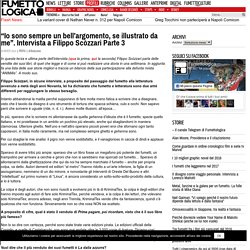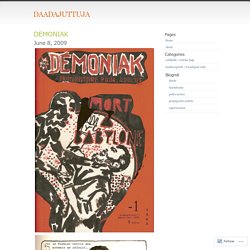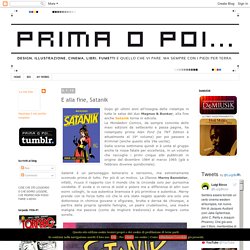

Fumetti di Carta: Satanik! SATANIKvol 1: Dic 1964 - Mar 1965 di Magnus & Bunker (Roberto Raviola e Luciano Secchi)

Movies (mostly cultish), TV, comedy, comics, Italian stuff etc. Twitter: @darklonelywater. Fenomeno fumetto: tra storia e futuro – Satyrnet.it. “Io sono sempre un bell’argomento, se illustrato da me”. Intervista a Filippo Scòzzari Parte 3. In questa terza e ultima parte dell’intervista (qua la prima, qui la seconda) Filippo Scòzzari parla delle vendite dei suoi libri, di quel che legge e di come si può realizzare una storia in una settimana.

In aggiunta fa una lista delle sue storie migliori e traccia un bilancio della sua partecipazione alla defunta rivista “ANIMAls”. A modo suo. Filippo Scòzzari, in alcune interviste, a proposito del passaggio dal fumetto alla letteratura avvenuto a metà degli anni Novanta, lei ha dichiarato che fumetto e letteratura sono due armi differenti per raggiungere lo stesso bersaglio. Intanto abbandonai la matita perché supponevo di fare molta meno fatica a scrivere che a disegnare, visto che il tavolo da disegno è uno strumento di tortura che spacca schiena, culo e occhi. Non sapevo però che scrivere è uguale (ride, n. d. r.). Psicologia dinamica del fumetto nero-
Intervista a Filippo Scozzari - minima&moralia. Di minima&moralia pubblicato lunedì, 15 febbraio 2010 · 1 Commento.

Filippo Scòzzari - Professionisti - Artisti - Flashfumetto. Filippo Scòzzari nasce nel 1946 a Bologna.

A metà degli anni Settanta esordisce sulle riviste Re Nudo e Il Mago (dove si firma con lo pseudonimo di “ Winslow Leech”). In quegli anni vive a Bologna in una casa occupata di Via Clavature, la famosa Traum Fabrik, dove si possono incontrare alcuni dei protagonisti più significativi della scena artistica bolognese degli anni ’70: alcuni dei futuri Gaz Nevada, e un giovane Andrea Pazienza. Proprio insieme a Pazienza, e ad altri fumettisti (Tanino Liberatore, Stefano Tamburini e Massimo Mattioli), nel 1977 viene creata la rivista Cannibale. Dal 1978 inizia a pubblicare sul settimanale satirico romano Il Male, dove nasce uno dei suoi personaggi più celebri: Suor Dentona. Insieme al direttore del Male Vincenzo Sparagna e al gruppo di Cannibale nel 1980 fonda il mensile Frigidaire.
Il BLOG di Scòzzari: manualedellartebimba.blogspot.com. Corto Maltese tra fumetto e letteratura disegnata. Dan Mazur's Comics – Page 10 – Comics I Made, Comics I'm Working On, Comics I Like, etc. Coming in June from publisher Thames and Hudson, “Comics: A Global History, 1968 to the Present,” written by Alexander Danner and me.

Here are some excerpts and expanded material, including some great images that couldn’t fit in the book.Text in italics is directly from the book. DAADAJUTTUJA. Gal Yacinthe Galbet?

(Frémok) Bizarre, sexually depraved covers of vintage Italian adult comics from the 70s and 80s. Bizarre, sexually depraved covers of vintage Italian adult comics from the 70s and 80s “Policewoman - Gay City” an adult themed comic from Italy, 1970s/1980s I love to blog about topics that are popular with the crowd on the wrong side of the tracks, and the unsettling, strange and straight up bizarre covers of the following vintage Italian comics that you are about to see, fall into that very category.

“Vital Energy” the cover of an adult Italian comic from the 1970s/1980s According to the book, Drawn and Dangerous: Italian Comics of the 1970s and 1980s, adult-themed Italian comics comics began to find their way to France, where they were translated and published starting in the very early 70s, which, before I’m schooled by our astute readers that some of the covers pictured here are not written in Italian, explains why some of the magazines in this post are in French. “The Razor’s Edge” “Musketeer” (printed in Italian) “Venice Vampires” “Sex Flower” “Domestic Men” A Great Painter Did It: The Compelling Weirdness of Magnus. By Richard McKenna / August 29, 2016 With a reputation for intractability and a ubiquity afforded him by a decades-long involvement in the Italian equivalent of the pulps, Magnus (not to be confused with his robot-punching namesake) was, until his death in 1996, one of Italy’s most prolific and distinctive comic book artists.
Magnus was born Roberto Raviola in the left-wing, north-Italian university city of Bologna in 1939 (a year after fellow Bolognese Pupi Avati, who directed the cult horror films The House with Laughing Windows and Zeder). In 1961 Raviola graduated with a diploma in scenery design from his hometown’s academy of fine arts, and it was the jokey motto of that institution’s students that provided him with his pen name: magnus pictor fecit—“a great painter did it.” Magnus is still a constant visual presence in Italy. PRIMA O POI...: E alla fine, Satanik. Dopo gli ultimi anni all'insegna delle ristampe in tutte le salse del duo Magnus & Bunker, alla fine anche Satanik torna in edicola.

La Mondadori Comics, da sempre convinta delle maxi edizioni da settecento e passa pagine, ha ristampato prima Alan Ford (la TNT Edition è attualmente al 19° volume) per poi passare a Kriminal (anche questo alla 19a uscita).Dalla scorsa settimana quindi si è unita al gruppo anche la rossa fatale per eccellenza, in un volume che raccoglie i primi cinque albi pubblicati in origine dal dicembre 1964 al marzo 1965 (già a febbraio divenne quindicinale). Satanik è un personaggio temerario e nerissimo, ma estremamente scomodo prima di tutto. Per più di un motivo. La 25enne Marny Bannister, infatti, ricuce il rapporto con il mondo che la circonda solo per purissima vendetta. E' avida e in cerca di soldi e potere ma a differenza di altri suoi esimi colleghi, la sua autentica bramosia è più primitiva e autentica. How Art Has Shaped Female Beauty Ideals throughout History.
Still, in recent years the forces shaping ideals of feminine physical beauty have shifted markedly.

The most notable of them is that, as part of a more general democratization of image consumption and production, women themselves began redefining the ideals to which they aspire. This means that many more notions of beauty are now available. Consider, for instance, the ways that figure shaping has altered over the centuries. Some 150 years ago, women in Europe began wearing bustles beneath their dresses that greatly enlarged the profile of their buttocks.
Glamazonia, il blog. Se della vita di Satanik abbiamo riassunto l’esistenza attraverso una vasta scelta di albi, di quella di Marny Bannister abbiamo ben poche testimonianze (anche se sufficientemente significative).

Sono quattro gli albi che ci mostrano squarci della sua tormentata esistenza: Il n. 1 “La Legge del Male“ il n. 47 “Il Faro del Golfo Nero“ il n. 62 “La vita sbagliata di Mae Wild“ il n. 185 “Le origini di Satanik“ Il n. 1 e il n. 185 sono direttamente collegati tra di loro e sono quelli maggiormente ricchi di indizi. QUELLA STRONZA DI SATANIK - GIORNALE POP - Lo sceneggiatore Luciano Secchi (Max Bunker) racconta che Satanik sarebbe dovuto essere il nome di Kriminal, per assonanza con Diabolik al quale si ispirava.
Satanik (Comic Book) "Cruelty. Sadism. Greed. Violence. This is Satanik. " Io, Mirka e Frieda – Gabriele Ferrero. Necron n. 1. A Great Painter Did It: The Compelling Weirdness of Magnus. Irenebrination: Notes on Architecture, Art, Fashion, Fashion Law & Technology: April 2010. People involved in the creative industries are often struck by rather bizarre or controversially demented ideas. For example, Jean-Louis Sherrer’s fashion house included Nazi insignia in its 1995 couture collection and there were often gangster connections in Dolce & Gabbana’s collections that seemed to be unfortunately timed with Mafia murders. History also left us with enough controversial works of art or films on which we could maybe write not just one essay, but entire books.
Yet the history of controversy wouldn’t be complete without a list of songwriters and musicians who dedicated tracks or music compositions to dubious characters. Diabolik & Fumetti Neri. Charles Burns. Charles Burns is today’s undisputed master of unsettling creepiness and not only in such American comics as Big Baby, Dog Boy, El Borbah, Black Hole and his latest, X’ed Out, but also in photography, animation, and set and costume design. A Great Painter Did It: The Compelling Weirdness of Magnus. From Supervillains to Sadomasochism: Diabolik, Kriminal, Baba Yaga, and Italian Pulp Comics on Screen - Diabolique Magazine.
Baba Yaga (1973) Thanks to the mainstream cinematic releases of the last few decades, the phrase “comic book adaptation” doesn’t exactly scream “cult film,” and certainly doesn’t imply plots teeming with sex, violence, hedonism, or sadomasochism. Enter Italy. Terre di Confine Magazine. Era il dicembre del 1964 quando appariva per la prima volta in edicola, con l’albo ‘La Legge del Male’, la serie Satanik firmata da Magnus (Roberto Raviola, disegni) e Max Bunker (Luciano Secchi, testi), destinata a portare per dieci anni un contributo unico al genere noir che imperversava in Italia nel periodo del boom economico. The Wild, Wild World of Diabolik & CO: Adults-only comic books on screen in the 1960s – Offscreen. Biography. Roberto Raviola was born in Bologna, Italy, on May 31st, 1939. Most of his childhood years were during and right after the end of WWII, when the majority of buildings had been bombed and were in ruins.
They became Roberto’s habitual playground, stimulating his fervid imagination since those early years. Right after completing elementary and middle school, his strong predilection for arts and drawing pushed him to attend Liceo Artistico (Arts High School) in Bologna. During those years his style was influenced by popular Italian comic strips such as L’Avventuroso and Il Vittorioso, Flash Gordon by Alex Raymond, “Saturno contro la Terra “ di Zavattini, Pedrocchi e Scolari, Mandrake and Faust by Rino Albertarelli, the Italian version of Mickey Mouse ( Topolino) by Floyd Gottfredson, and the heroic epic stories of the American Far West.
He signed his work with the name Bob Patterson and later Bob La Volpe. He also cooperated with G.I.T. Chi Sono » Max Bunker. Chi sono ? Luciano Secchi/Max Bunker Max Bunker è il mio nom-de-plume, al secolo Luciano Secchi. C’è chi afferma che sono uno degli autori più prolifici del fumetto italiano, altri che sono un padre nobile del fumetto autoctono, altri ancora che sono un grande innovatore della bande-dessinée italica. Exclusive Look at Paul Pope’s ADC Screenprints. The Art Directors Club in NYC kicks off their holiday party dubbed the December Editions tonight. A select group of artists will be showing off their respective limited edition prints including Paul Pope, you know, the guy who made Batman: Year 100. Anyway, admission to ADC’s Holiday Party is $20, which will benefit The Children’s Aid Society.
You can also donate a new, unwrapped toy or children’s book. We had a quick chat with Paul about tonight’s show, what pieces we’ll be seeing and other comic book related nerdery. You’re a pretty multifaceted individual. Crepax e il fumetto a ritmo di jazz. Lucio Filipponio Se il bianco e nero è il colore del fumetto, Guido Crepax ne è stato il suo Charlie Parker!
Proprio nellanima più noir del virtuoso della vignetta va rintracciato il nesso viscerale tra due arti solo in apparenza così distanti. O meglio sono quattro gli elementi interconnessi: Crepax, il jazz, il fumetto ed il bianco/nero. Quattro facce dello stesso immaginario collettivo. Non è un caso, dunque, che Mario Ciampà ed Elisabetta Pisu abbiano deciso di allestire la mostra Guido Crepax e il jazz, presso lAuditorium Arte.Nellambito del «Roma Jazz Festival» prende vita lidea di esporre, per la prima volta in maniera organica, i disegni e le tavole sul jazz dellartista milanese. Tutt'a un tratto: una storia della linea del fumetto - Sergio Algozzino. The Visual Linguist: How to analyze comics with narrative grammar. Over the past several years, I've presented a lot of evidence that panel-to-panel "transitions" cannot account for how we understand sequences of images in visual narratives like comics.
Rather, I've argued that narrative sequential images use a "narrative grammar" that assigns roles to panels, and then groups panels into hierarchic relationships. Though there are many reasons panel transitions don't work to explain how we understand sequential images, one of the reasons why panel transitions as a theory may be attractive is because it is intuitive to see outright. A person can easily look at a sequence and assign transitions between panels and it "feels" right because that matches one's conscious experience of reading a comic (though it is not very cognitively accurate).
Italy in the 1960s: A Legacy of Terrorism and Liberation on JSTOR. Fascism in Italian Cinema since 1945, Giacomo Lichtner. Post-War Italian Cinema: American Intervention, Vatican Interests - Daniela Treveri Gennari - Google Books. THE ITALIAN ECONOMIC MIRACLE AND ORGANIZED LABOR on JSTOR. From Supervillains to Sadomasochism: Diabolik, Kriminal, Baba Yaga, and Italian Pulp Comics on Screen - Diabolique Magazine. Nona Arte. Saggio storico sul fumetto. Luca Raffaelli, Valentina di Guido Crepax, da: "I classici del fumetto di Repubblica", 2003. - Letteratura&Grafica. Guido Crepax. The post-war generation: Growing up and coming of age in 1950s Italy – Niamh Cullen. Evolution Of Italian Cinema: Neorealism To Post-Modernism.
The Position Of Women In Fascist Society. Glamour and the italian female film stars of the 1950S: Historical Journal of Film, Radio and Television: Vol 28, No 3. Review of Drawn and Dangerous: Italian Comics of the 1970s and 1980s. Comics, a Global History: “Fumetti neri” – Dan Mazur's Comics. Fumetti Erotici d'Epoca Characters - Comic Vine. Women in Comics (Concept) - Comic Vine.
Italy's Fumetti: Curiously Sophisticated Pulp Comics. Bibliografia sul fumetto. From Supervillains to Sadomasochism: Diabolik, Kriminal, Baba Yaga, and Italian Pulp Comics on Screen - Diabolique Magazine. A Comic Book Character Seeks Sexual Empowerment in Postwar Italy. What Do Comic Books Teach Us About Gender Attitudes? CURVE PERICOLOSE : LA STORIA DELLA PANTERA BIONDA.
The Literature: Afterthoughts on "Visual Pleasure and Narrative Cinema" inspired by Duel in the Sun by Laura Mulvey. Il fumetto in Italia tra pop culture e letteratura. Corto Maltese tra fumetto e letteratura disegnata. Italian comics and cinema: forms and functions... Il fumetto fra pedagogia e racconto by Tunué - Tutta un'altra storia.